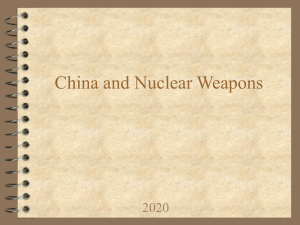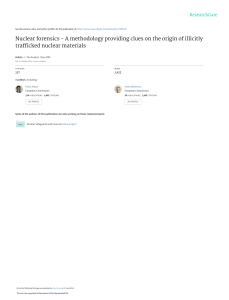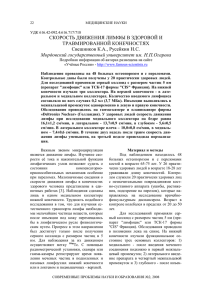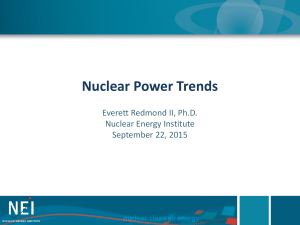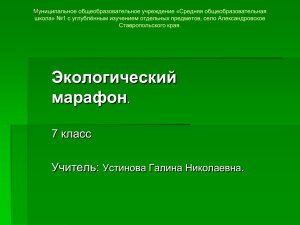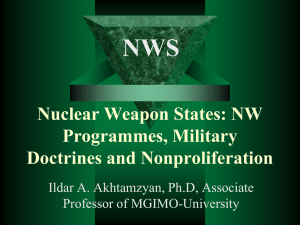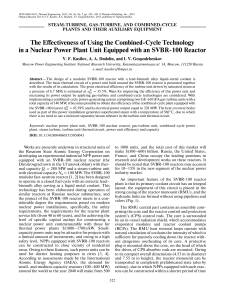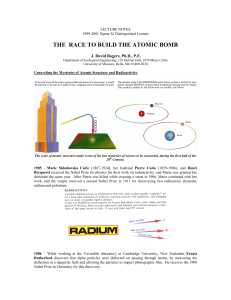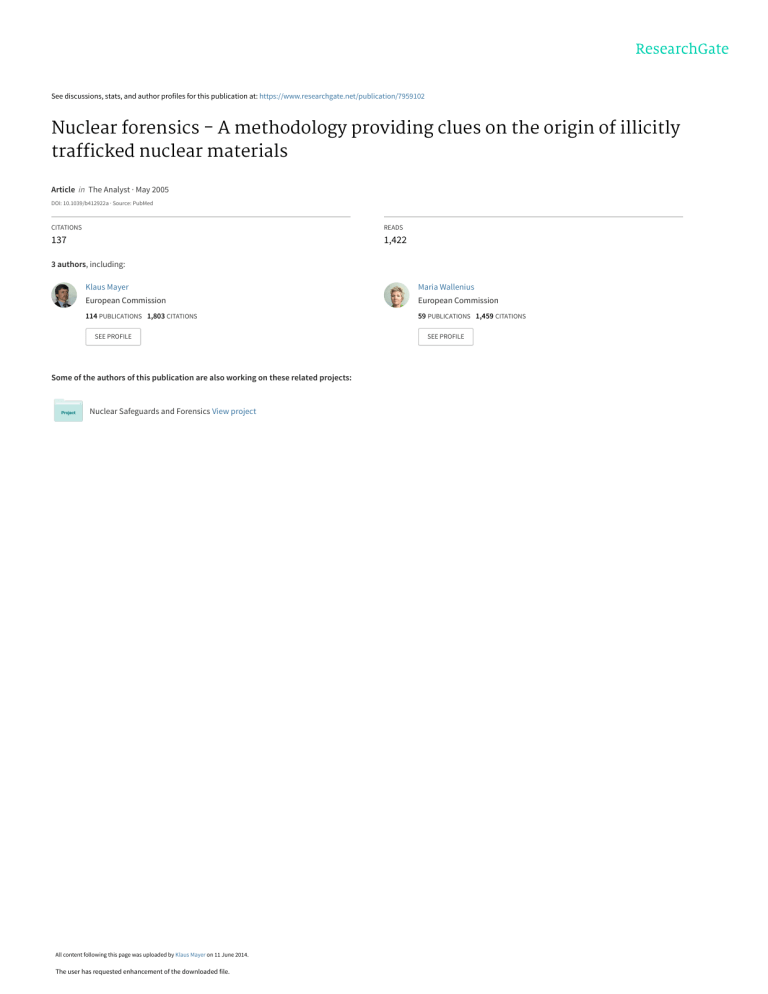
See discussions, stats, and author profiles for this publication at: https://www.researchgate.net/publication/7959102 Nuclear forensics - A methodology providing clues on the origin of illicitly trafficked nuclear materials Article in The Analyst · May 2005 DOI: 10.1039/b412922a · Source: PubMed CITATIONS READS 137 1,422 3 authors, including: Klaus Mayer Maria Wallenius European Commission European Commission 114 PUBLICATIONS 1,803 CITATIONS 59 PUBLICATIONS 1,459 CITATIONS SEE PROFILE Some of the authors of this publication are also working on these related projects: Nuclear Safeguards and Forensics View project All content following this page was uploaded by Klaus Mayer on 11 June 2014. The user has requested enhancement of the downloaded file. SEE PROFILE i-SECTION: TUTORIAL REVIEW www.rsc.org/analyst | The Analyst Nuclear forensics—a methodology providing clues on the origin of illicitly trafficked nuclear materials Klaus Mayer,* Maria Wallenius and Ian Ray Received 20th August 2004, Accepted 18th November 2004 First published as an Advance Article on the web 21st December 2004 DOI: 10.1039/b412922a 1. Introduction Reports on seizures of nuclear material (i.e., uranium or plutonium) and of radioactive sources continue to attract the attention of the public and are a reason for concern due to the hazard associated with such material. Once the material has been detected and secured, the questions on the intended use, the radiological hazard and the origin of the material need to be answered. Classical forensic techniques address the criminalistic part of the case, i.e., the identification of the suspect criminal. The phenomenon of nuclear smuggling and illicit trafficking of nuclear material has led to the development of a new branch of science: nuclear forensics. The key issue is the identification of the origin of the material, in order to improve the physical protection measures and prevent future thefts or diversions. The key challenge is the specificity and complexity of the nuclear area and the particular requirements for handling such material. Nuclear forensic science makes use of analytical techniques that were actually developed for applications related to the nuclear fuel cycle, hence appropriate and safe handling of the samples during the investigations is assured. For interpretation of the results, nuclear forensic science relies to a large extent on the expertise and experience of the investigating scientists. Knowledge in areas *[email protected] Klaus Mayer received his MSc in Chemistry from the Technical University of Karlsruhe in 1985, followed by a PhD in Radioand Analytical Chemistry in 1987. After a post-doctoral fellowship at ITU, he joined the Institute for Reference Materials and Measurements in 1990 and worked on high accuracy isotope mass spectrometry and isotopic reference material for uranium and plutonium and on nuclear safeguards. In 1996 he returned to ITU, responsible for the set-up and the installation of safeguards on-site laboratories. Today, he is in charge of the Safeguards Programme of ITU and of the development of measurement methodologies for nuclear materials, including nuclear forensic analysis. He is author of over 150 publications, and acts as co-chairman of the International Technical Working Group on Nuclear Smuggling Klaus Mayer (ITWG). This journal is ß The Royal Society of Chemistry 2005 such as radiochemistry, nuclear physics, reactor physics, materials science and in the nuclear fuel cycle are required. The conclusions, however, need to be supported by reference data wherever possible. 2. Methodological approach Nuclear forensic investigations will start after material has been seized and categorized as ‘nuclear material’. They are carried out in order to answer specific questions on the nature Maria Wallenius received her MSc in Radiochemistry at the University of Helsinki, Finland in 1994. She worked at the University of Helsinki as a research scientist in the safeguards project (Determination of uranium content, isotopic composition and impurities in fresh nuclear fuel by various techniques) and then moved to the Institute for Transuranium Elements (ITU) in 1996 to study for a PhD in Radiochemistry Maria Wallenius (‘‘Origin determination of reactor produced plutonium by mass spectrometric techniques: Application to nuclear forensic science and safeguards’’) which she obtained in 2001. She continued at the ITU as a research scientist developing new methods using mass spectrometry (especially using TIMS and ICP-MS) in the field of safeguards and nuclear forensics. Ian Ray received his MA in Natural Sciences at the University of Cambridge in 1966 and his DPhil at the University of Oxford in 1971 in the field of high resolution electron microscopy. After a short period lecturing in the University he joined the Institute for Transuranium Elements in Karlsruhe, Germany, in 1976 and took over responsibility for the electron microscope laboratory. Since 1999 he has been responsible for the coordination of Nuclear Forensic Science activities in Ian Ray the Institute. Analyst, 2005, 130, 433–441 | 433 of the material and its origin, such as the intended use, the mode of production, the plant and production batch, the last legal owner and the smuggling route. The investigations may comprise conventional forensic tests applied to radioactive material, the morphology of the material, the structure of the material components, the composition of traces in the material and its packing, the isotopic composition of the nuclear material itself and of minor constituents. Nuclear forensic investigations basically draw upon the information inherent to the material. Nuclear material is generally of anthropogenic origin, i.e., the result of a production process. The nature of this production process is reflected in the elemental and isotopic composition of the material as well as in its microscopic and macroscopic appearance. All of these parameters can be measured using the appropriate analytical technique. Some parameters can be combined to a ‘‘nuclear fingerprint’’, i.e., they are characteristic for the mode of production of the material. Hence, they may provide a clue as to the origin of the material. Nuclear material is either produced by uranium mining, which is normally followed by isotope enrichment of uranium, or by neutron capture (e.g., in a reactor), which transforms uranium into the transuranium elements neptunium, plutonium, etc. The isotopic composition of the latter depends on the reactor conditions and thus allows the drawing of conclusions on the reactor type and the fuel initially used.1 Consequently, a suite of analytical techniques, specifically adapted to the needs of radioactive material, is required. 3. Analytical techniques The analytical techniques used in nuclear forensic investigations may be subdivided into two categories: commonly applied chemical and physical analytical methods and radioanalytical methods. The latter make use of the radiation emitted from the material. This radiation is characteristic for the emitting nuclide. The two categories of analytical techniques offer results of complementary nature, thus Table 1 providing a maximum of information on the material under investigation. Table 1 summarizes the analytical techniques used most commonly in nuclear forensic investigations. Some techniques are applicable to radioactive materials only (e.g., alpha or gamma spectrometry) but most of the methods are commonly applied in analytical chemistry or in materials science (e.g., secondary ion mass spectrometry [SIMS], scanning electron microscopy [SEM]). In the latter case the techniques need to be adapted to the specific requirements associated with handling radioactive materials (glove-boxes, shielding, etc.). Controlling the radiological hazard is of paramount importance at all stages of the investigation. Furthermore, attention should be paid to preserving classical forensic evidence. In the nuclear analytical laboratory, the material is first subjected to visual inspection. This may already reveal useful information on the material itself (e.g., physical form, geometry, primary packing) and provide the starting point for further analysis. It may be complemented by imaging techniques, namely optical microscopy for examination of the sample at high magnification. If the analysed material contains fuel pellets, their dimensions (height, diameter and the size of a possible central hole) and mass are measured. These so-called macroscopic parameters, together with the 235U enrichment, are characteristic and they can already reveal the reactor type, where the pellets are used. Seizures occur under varying circumstances: at border crossings, during searches on specific targets or just by accident. They reveal nuclear material in different amounts and different shapes. Figs. 1–4 illustrate this variety. 3.1. Radiometric methods Radiometric techniques measure the radiation that radioactive nuclides emit when they decay to a daughter nuclide. Most of the heavy nuclides (e.g., U and Pu) decay by emitting an alpha particle. However, gamma radiation is also often emitted after the alpha decay to bring the daughter nuclide from an excited Techniques used for analysing seized nuclear material Techniques/methods First analysis Information Radiological Estimated total activity Dose rate (a, c, n) Surface contamination Visual inspection Photography Size measurement Optical microscopy Radiography Weighing Fingerprints, fibers c-Spectroscopy Radiological hazard Precautions Physical characterization Traditional forensic analysis Isotope analysis Elemental/Chemical analysis 434 | Analyst, 2005, 130, 433–441 Detailed analysis Information SEM (EDX) Microstructure and elemental composition Crystal structure Microstructure Macroscopic dimensions XRD TEM Mass Isotopic composition Mass spectrometry (SIMS, TIMS, MC-ICP-MS) Radiochemical separations a-spectrometry ICP-MS XRF Assay (titration, IDMS) GC-MS Accurate isotopic composition Chemical impurities Chemical composition This journal is ß The Royal Society of Chemistry 2005 Fig. 1 Sample of uranium–plutonium mixed oxide powder seized in Munich (Germany) in 1994. Fig. 4 Uranium oxide fuel pellet, intended for RBMK-1500 reactor, seized in Lithuania. state to the ground state. Each nuclide emits gamma rays of energies characteristic of this particular nuclide. Fig. 2 Sample of yellow cake, containing natural uranium, seized in Rotterdam (NL) in 2003. Fig. 3 Piece of contaminated scrap metal and highly radioactive particle, seized in Karlsruhe (Germany) in 1997. This journal is ß The Royal Society of Chemistry 2005 3.1.1. Gamma spectrometry. Gamma spectrometry is the first technique that is used when seized nuclear material is investigated. This is essentially due to the non-destructive character of the technique, gamma rays, i.e., photons of some ten up to several hundred keV, are only slightly attenuated by the packing material (unless shielding like lead is used). Thus, already the initial measurements in the field (e.g., in border control points) are carried out with simple, portable gamma spectrometers. They aim at a categorisation of the material, i.e., distinguish between naturally occurring radioactive material, radioactive source, radiotherapy nuclide or nuclear material. In laboratories, more sophisticated gamma spectrometers, so-called high resolution gamma spectrometers (HRGS), are used. Their energy resolution is much better than in the portable instruments, thus gamma rays with energies very close to each other can be resolved in the spectrum. Specific codes like the MGA,2 FRAM3 or MGAU4 codes are used to deconvolute the low-energy spectra observed for plutonium and uranium, respectively, and allow calculation of the isotopic composition of the material. It should, however, be noted that some nuclides like 242Pu or 236 U cannot be detected by gamma spectrometry; in these cases mass spectrometry offers a useful analytical altenative. An example of a gamma spectrum of a natural uranium sample is shown in Fig. 5. 3.1.2. Alpha spectrometry. Alpha particles, i.e., 42 He2+ having energies of 3–8 MeV, are stopped for example by a paper sheet, because of their strong interaction with matter. Consequently, an alpha measurement through packing material or shielding is impossible. Alpha spectrometry is a destructive technique, which requires rather laborious sample preparation. This may include dissolution, chemical separation and target preparation. Pu/Am separation is especially important because the alpha particles emitted by 238Pu and 241Am have similar energies and thus overlap in the spectrum. Similarly, the alpha energies of 239Pu and 240Pu are very close and cannot be Analyst, 2005, 130, 433–441 | 435 Fig. 5 Gamma spectrum of the yellow cake sample shown in Fig. 2. The spectrum proves that the material consists of natural uranium: the isotopic composition was determined by analysing the energy range indicated. resolved in the spectrum; consequently they can be measured only as a sum. Alpha spectrometry offers low detection limits for Pu measurements, due to the relatively short half-lives of the plutonium isotopes (e.g., half-life of 238Pu is 87.7 a). 3.2. Mass spectrometry Mass spectrometric techniques make use of the mass differences between nuclides. If these are nuclides of the same chemical element, they are called isotopes. The isotopic composition of uranium and plutonium is an important parameter for determining the mode of production of the material. In mass spectrometry the atoms contained in a sample are converted to ions and then separated according to their mass (actually, according to their mass to charge ratio). Mass spectrometric techniques can be applied to both radioactive and stable isotopes. 3.2.1. Thermal ionisation mass spectrometry. Thermal ionisation mass spectrometry (TIMS) is a routinely used method for the determination of the isotopic composition of U and Pu. If a known amount of a spike (an isotope not occurring in the samples or only in small abundance) is added, the amount of the element under investigation can be determined quantitatively (element assay) by so-called isotope dilution mass spectrometry. A small amount of sample (some nanograms up to few micrograms) is deposited on a metallic filament. Ions are produced by resistive heating of the filament. Modern instruments offer so-called multi-collector detection, thus enabling the simultaneous measurement of the ion currents of different isotopes. Thermal ionisation mass spectrometry provides isotope ratio data of high precision and accuracy. A disadvantage of the TIMS technique is the laborious sample preparation. As in the case of alpha spectrometry, the sample needs to be dissolved and chemically separated and purified in order to avoid mass interferences. 3.2.2. Inductively coupled plasma mass spectrometry. Inductively coupled plasma mass spectrometry (ICP-MS) is a 436 | Analyst, 2005, 130, 433–441 versatile technique that came to the market in the 1980s and was used mainly for impurity measurements. Samples are usually introduced in the form of an aerosol, which is generated by nebulizing the sample solution. The ions are produced in the plasma at temperatures of 5000–8000 K. The salient features of ICP-MS are the multi-element capability, the high sample throughput, the good sensitivity and the large dynamic range. In modern instruments magnetic sectors are replacing the quadrupoles for mass separation. Consequently, multi collector detection (enabling simultaneous detection of different isotopes) can be combined with the ICP-source, and isotope ratios can be measured at precisions similar to those of the TIMS technique. ICP-MS measurements have been applied for impurity measurements as well as for isotope ratio measurements in seized samples and in samples of known origin.5,6 3.2.3. Glow discharge mass spectrometry. Glow discharge mass spectrometry is the most comprehensive and sensitive technique available for the analysis of inorganic solids. It is capable of analyzing conducting, semi-conducting and insulating samples. Its elemental coverage encompasses lithium through uranium, with the ability to determine impurity levels from the sub-ppb range to the percent level. In glow discharge mass spectrometry (GD-MS) the solid sample serves as the cathode for the sputtering and ionisation processes. Basically, it can be used for the same purpose as ICP-MS, i.e., impurity and isotope ratio measurements.7 GD-MS can be a very effective tool for panoramic impurity analysis in solid samples. However, it suffers from matrix-effects and does not reach the degree of precision and accuracy achieved in TIMS or ICPMS. Due to the small spot size that is sputtered, sample heterogeneity may yield misleading results. The fact that the analysis is directly performed from solid samples and that very small samples can be investigated are most advantageous features of this technique. 3.2.4. Secondary ion mass spectrometry. Secondary ion mass spectrometry (SIMS) is a microanalytical technique, applicable even to micrometer sized particles. It offers both elemental and isotopic information. A finely focused primary ion beam (e.g., O+ or Cs+) hits the sample and sputters atoms from the surface. These secondary ions then pass a mass spectrometer for analysis. SIMS is applied in nuclear forensics when only small amounts of sample (e.g., particles) are available or when the sample is inhomogeneous (e.g., a powder mixture) and the individual constituents are to be investigated.8,9 3.3. Microstructural techniques 3.3.1. Profilometry. Profilometry is used to measure, for example, the surface roughness of the materials and crater depth after sputtering. In the nuclear field this technique can be used to determine the surface roughness of fuel pellets. Fuel pellets are finished by grinding to bring the cylindrical shape to the specified diameter with low tolerance. There are two different grinding procedures used, so-called wet and dry grinding. By wet grinding a generally smoother surface is achieved than by dry grinding. Thus, if pellets for a certain This journal is ß The Royal Society of Chemistry 2005 Table 2 Typical sample sizes and typically achieved measurement uncertainties Technique Parameter investigated Typical sample mass or particle diameter Typical relative measurement uncertainty TIMS Isotope ratios 10 ng–1 mg 0.05%–1% ICP-MS Isotope ratios Concentration 0.1 ng–1 mg 0.1 pg–1 mg 0.1%–2% 1%–30% GDMS Isotope ratios Concentration 1–100 mg 1–100 mg 1%–10% 15%–25% SIMS Isotope ratios Concentration .0.5 mm .0.5 mm 1%–10% 10–20% Fig. 6 SEM picture of a PuO2 reference sample of a known fabrication plant. type of reactor are produced in several fabrication plants, they can be distinguished from each other by surface roughness, if the plants use different grinding methods.10 3.3.2. Electron microscopy. Electron microscopes use a focused beam of electrons of high energy to examine objects on a very fine scale. Interactions with the sample affect the electron beam. These effects are detected and transformed into an image, a spectrum or a diffraction pattern. This may yield information on topography, morphology, elemental composition and crystallographic structure, and lead to the development of the concept of a microstructural fingerprint.11 3.3.2.1. Scanning electron microscopy. Scanning electron microscopy (SEM) provides pictures of the surface of objects at high magnification and with a large depth of field. SEM detects the electrons that are back-scattered or emitted (i.e., secondary electrons) from the specimen’s surface. The characteristic X-rays emitted from the specimen due to fluorescence provide information on the chemical elements contained in the material. Preparation of the samples is relatively easy since most SEMs only require the sample to be conductive. In nuclear forensics, the application of SEM is particularly interesting for powder samples or inhomogeneous samples. Different components can be investigated separately for their particle morphology and elemental composition, thus possibly providing hints on the production process. A sample seized at Munich Airport in 1994 consisted of a powder mixture of three components: uranium, plutonium rod shaped particles and plutonium platelets. These last were investigated in detail by SEM and TEM as shown in Figs. 6–11. While the SEM pictures do not allow us to unambiguously distinguish between the two materials, TEM analysis provides complementary and useful information. 3.3.2.2. Transmission electron microscopy. Transmission electron microscopy (TEM) makes use of the electrons that have passed through the specimen. Therefore only thin layers can be examined. The sample preparation is rather laborious. However, the resolution reaches the sub-nanometre range. The results obtained by SEM and TEM clearly show that the two materials originate form different processes. The significantly different grain size distribution indicates that the This journal is ß The Royal Society of Chemistry 2005 Fig. 7 SEM picture of PuO2 platelets from a sample seized in 1994 at Munich Airport, Germany. Fig. 8 The platelet size distribution was established by SEM for the two samples. It does, however, not show a significant difference between the two samples. techniques for precipitation and the conditions for calcining the material were not identical. 4. New developments When the phenomenon of nuclear smuggling appeared in the early 1990s and the first seized samples needed to be investigated, the methods available in other fields (e.g., safeguards analysis) were applied for nuclear forensic analysis; Analyst, 2005, 130, 433–441 | 437 Fig. 9 TEM picture of PuO2 platelets from a sample seized in 1994 at Munich Airport, Germany. Fig. 10 TEM picture of a PuO2 reference sample of a known fabrication plant. Please note Figs. 9 and 10 are at the same magnification. Fig. 11 The grain size distribution was established by TEM for the two samples. It reveals a remarkable difference, indicating a different production process used for manufacturing the PuO2. no specialised methods were available. Later, the methods were adapted and focused to the specific needs of nuclear forensics. However, it was then noticed that new methods dedicated only to the investigation of nuclear forensic materials needed to be developed in order to obtain specific information. In this chapter the main developments from recent years are discussed. 4.1. Age determination Determination of the age of materials is common in geology and archaeology. The age of organic materials (e.g., bones) is determined using the 14C ‘‘clock’’, whereas inorganic materials 438 | Analyst, 2005, 130, 433–441 (e.g., minerals) have several more possibilities for age determination (e.g., measurement of isotope abundance ratios in Sr/Rb, Sm/Nd, U/Pb). Basically, the disintegration of a radioactive (parent-) isotope and the build up of a corresponding amount of daughter nuclide serve as a built-in chronometer. The same principle is applicable to nuclear materials, albeit under different boundary conditions, because the time periods to be determined (age of the material, i.e., time elapsed since the last purification of the material) are short compared with the half-life of the nuclides. This means that in this short time only a small amount of daughter nuclide will grow-in. Thus, the resulting parent/daughter ratios are always very high, which often makes the direct measurement impossible. Additionally, a separation and some very sensitive measurement techniques are required. Useful parent/ daughter pairs are 234U/230Th and 235U/231Pa, and in the case of plutonium, 238Pu/234U, 239Pu/235U, 240Pu/236U and 241Pu/241Am. As the daughter products are also radioactive, the granddaughters (e.g., 234U/226Ra) as well can be used for the age determination. First, the age determination was developed for bulk plutonium samples. This is classically achieved by a c-spectrometric measurement of the 241Pu/241Am ratio. In a more recent work, the samples were spiked with 244Pu, 243Am and 233U, and elements were separated and measured by TIMS.12 If consistent ages are obtained for the four useful parent/daughter relationships, systematic errors can be excluded. Incomplete separation of the initial material will not properly set the clock to zero. The impact on the age determination of residual uranium in a plutonium sample was studied for different types of plutonium.13 Age determination of Pu particles poses a particular challenge.14 In the case of single particles, no U/Pu/Am separation can be performed; the isotope ratios need to be measured directly by SIMS. Parent/daughter ratios suffering from isobaric interferences (e.g., 241Pu/241Am) cannot be used for age determination. As outlined above, the consistency of results allows the drawing of conclusions on possibly present residual uranium. For an accurate age determination, measurement effects (due to, for example, different ionisation potentials of U and Pu) need to be quantified and corrected for. Owing to the long half-lives of the uranium isotopes and consequently the small amounts of daughter products growing in, age determination of uranium is more challenging than for plutonium. The preferred parent/daughter relation is the 234 U/230Th, although 234U is a minor abundant isotope in uranium. U age determination has been demonstrated for a wide range of 235U enrichments, from natural uranium up to highly enriched material.15–18 Three different methods for quantifying the daughter nuclide have been tested, i.e., alpha spectrometry using 228Th as a spike, TIMS using 232 Th as a spike and ICP-MS without spiking, in other words direct ratio measurement. U age determination has also been demonstrated using the other parent/daughter relationship 235U/231Pa by alpha spectrometry; however, this suffers from a lack of suitable spike isotopes of Pa.19 The longest living Pa isotope after 231Pa is 233Pa, with a half-life of 27 days. This journal is ß The Royal Society of Chemistry 2005 4.2. Reactor type determination (Pu production) Plutonium is generated in nuclear reactors after neutron capture of uranium and subsequent decay of the intermediate product. Heavier isotopes of plutonium are produced by further neutron captures. The probability for this reaction (the so-called cross section) depends on the energy of the neutrons and varies also from one Pu isotope to the other. Different reactor types show different neutron energy distributions, therefore the plutonium isotopic composition is a key parameter for the identification of the reactor type where the Pu was produced. The isotopic composition of Pu is influenced by several parameters. These include the neutron spectrum of the reactor (hard or soft, i.e., fast or thermal neutrons), initial U fuel composition (235U enrichment) and burn-up (duration and intensity of irradiation in the reactor). The isotopic composition of Pu in most common reactor types (e.g., lightwater reactor, heavy-water reactor, fast breeder reactor) can be calculated using computer codes, e.g. ORIGEN20 and SCALE;21 thus measured data from seized samples can be compared to calculated values. A correlation was found that separates the main reactor types clearly from each other (Fig. 12).22,23 The 238Pu abundance (x-axis) is affected by the initial enrichment of the 235U in the fuel, i.e., the higher the enrichment, the higher the 238Pu abundance. The y-axis (242Pu/240Pu ratio) is affected by the neutron spectrum, i.e., the softer the spectrum, the higher the ratio. 4.3. Geolocation The natural variations in the isotopic composition of certain elements may provide clues on the geographic origin of the material, and is in fact one of the methodologies used in geolocation.24 Oxygen in nature consists of three stable isotopes, 16O (99.762%), 17O (0.038%) and 18O (0.200%). However, the isotopic composition can vary slightly due to the different chemical and physical reactionships (e.g., isotope exchange, evaporation, condensation) and lead to isotopic fractionation. Relative variations up to 5% in the 18O/16O ratio have been observed in rain water. These variations depend on the average annual temperature, the average distance from the ocean and on the latitude. As water is a common solvent in uranium processing and isotopic exchange during the processing can be assumed, geographical differences in 18O/16O ratio will be reflected in the UO2 product. An intensive study was performed using three mass spectrometric techniques, TIMS, SIMS and GDMS. In particular the TIMS and SIMS results reveal significant differences between UO2 pellets produced in different locations.25–27 Also other parameters are being studied for geolocation purposes. In natural uranium the chemical impurities may provide information on the ore body where the material was mined. Furthermore, it could be shown that the isotopic composition of stable elements (e.g., Pb28,29) also shows significant variations that may be attributed to the origin of the material. TIMS and ICP-MS are used for accurate determination of the isotopic composition of the relevant elements. 5. Reference data The information obtained from the analysis of seized nuclear material may be of endogenic or of exogenic nature. The first is self-explanatory, e.g. the age of the material, also the intended use (e.g., power production, weapons) can be deduced directly from the measured data. The second category requires reference data for comparison in order to identify, for example, the place of production. Information on nuclear fuel materials has been compiled in a relational database from the Fig. 12 The isotopic composition of plutonium indicates the reactor type in which the material was produced. Isotopic correlations were calculated for different reactor types and a number of samples were attributed to reactor types. NBS reference materials SRM 946 and 947 originate from light water reactors, two samples of Russian origin R1 and R2 were apparently produced in a materials testing reactor (MTR) and in an RBMK reactor. The material used in the ITWG round robin exercise, RR, originates from a PWR. The plutonium seized at Munich airport in 1994, F19, was most likely generated in an RBMK reactor. This journal is ß The Royal Society of Chemistry 2005 Analyst, 2005, 130, 433–441 | 439 open literature and from bilateral agreements with fuel manufacturers. The database contains information on pellet geometry, uranium enrichment, specified values for chemical impurities, manufacturer and reactor type and location. The database is used to guide the analysis in a step-by-step approach. The identification of the origin of the material is achieved on the basis of the exclusion principle.30–32 The database has recently been complemented by an electronic literature archive on non-conventional fuels.33 6. International co-operation Nuclear forensic science is closely related to the phenomenon of illicit trafficking, thus to nuclear security and nuclear safeguards. A border crossing threat is associated with it, which calls for an internationally co-ordinated response.34 The International Technical Working Group on combating nuclear smuggling (ITWG) was established some ten years ago, in order to advance the science of nuclear forensics for attributing nuclear material.35 This is achieved by exchange of information, by developing procedures and recommendations and by exercises.36,37 A number of bi- or multilateral assistance programmes have been set up in order to improve the detection capabilities and to arrange for nuclear forensic assistance.38 Also, the International Atomic Energy Agency promotes the development of nuclear forensics and facilitates the provision of assistance to requesting states which do not have their own nuclear forensic capabilities.39 7. Conclusions In the last fifteen years we have see the emergence of a new and potentially hazardous form of smuggling: that of nuclear and radioactive materials. This triggered the development of a new discipline in science, enabling support of law enforcement authorities in combating illicit trafficking and dealing with criminal environmental issues: nuclear forensics. Existing analytical techniques, as used in material science, in nuclear material safeguards and in environmental analysis, were adapted to the specific needs of nuclear forensic investigations. Characteristic parameters (e.g., isotopic composition, chemical impurities, macro- and microstructure) can be combined to a ‘‘nuclear fingerprint’’, pointing at the origin of the material. Further research is being carried out, aiming at identifying other useful material characteristics in order to reduce the ambiguities often remaining in the interpretation of the data and in the source attribution. New methodologies need to be developed, validated and implemented in order to determine parameters with good precision and accuracy. The availability of up-to-date reference on nuclear material is essential in order to identify the origin and the intended use of the material, or to exclude certain origins. Significant progress has been achieved in a relatively short time in this new and fascinating discipline. Due to the nature of the material involved and the related handling problems, the specific adaptation of measurement instrumentation, the complexity of the data interpretation and the particular expertise required, only few laboratories are working in this 440 | Analyst, 2005, 130, 433–441 area. However, the hazards involved with nuclear smuggling and the potential relation with nuclear terrorism are the driving forces for deploying and further improving this methodology. Klaus Mayer,* Maria Wallenius and Ian Ray European Commission, Joint Research Centre, Institute for Transuranium Elements, P.O.Box 2340, 76125 Karlsruhe, Germany. E-mail: [email protected] References 1 M. Wallenius, Origin Determination of Reactor Produced Plutonium by Mass Spectrometric Techniques: Application to Nuclear Forensic Science and Safeguards, Thesis, University of Helsinki, http:// ethesis.helsinki.fi/julkaisut/mat/kemia/vk/wallenius/. 2 R. Gunnink, MGA: A Gamma-Ray Spectrum Analysis Code for Determining Plutonium Isotopic Abundances, vol. 1, Methods and Algorithms, Lawrence Livermore National Laboratory, USA, UCRL-LR-103220, 3 April 1990. 3 T. E. Sampson, G. W. Nelson and T. A. Kelly, FRAM: A versatile Code for Analyzing the Isotopic Ratios of Plutonium from GammaRay Pulse Height Spectra, Los Alamos National Laboratory Report LA-11720-MS, December 1989. 4 R. Gunnink, W. Ruhter, P. Miller, J. Goerten, M. Swinhoe, H. Wagner, J. Verplancke, M. Bickel and S. Abousahl, MGAU: A New Analysis Code for Measuring U-235 Enrichments in Arbitrary Samples, Presented at the IAEA Symposium on International Safeguards, Vienna, Austria, March 8–14, 1994, ISBN 92-0-101994-7. 5 M. Wallenius, K. Mayer, A. Nicholl and J. Horta, Investigation of Correlations in Some Chemical Impurities and Isotope Ratios for Nuclear Forensic Purposes; International Conference on Advances in Destructive and Non-Destructive Analysis for Environmental Monitoring and Nuclear Forensics, Karlsruhe, Germany, 21–23 October 2002, http://www-pub.iaea.org/MTCD/publications/PDF/ Pub1169_web.pdf. 6 K. Mayer, G. Rasmussen, M. Hild, E. Zuleger, H. Ottmar, S. Abousahl and E. Hrnecek, Application of Isotopic Fingerprinting in Nuclear Forensic Investigations—A Case Study; International Conference on Advances in Destructive and Non-Destructive Analysis for Environmental Monitoring and Nuclear Forensics, Karlsruhe, Germany, 21–23 October 2002, http://www-pub.iaea.org/MTCD/publications/PDF/ Pub1169_web.pdf. 7 L. Pajo, A. Schubert, L. Aldave, L. Koch, Y. K. Bibilashvili, J. Dolgov and N. A. Chorokhov, J. Radioanal. Nucl. Chem., 2001, 250, 1, 79–84. 8 M. Betti, G. Tamborini and L. Koch, Anal. Chem., 1999, 71, 14, 2616–2622. 9 G. Tamborini, M. Wallenius, O. Bildstein, L. Pajo and M. Betti, Microchim. Acta, 2002, 139, 185–188. 10 L. Pajo, UO2 fuel pellet impurities, pellet surface roughness and n(18O)/n(16O) ratios applied to nuclear forensic science, Thesis, University of Helsinki, http://ethesis.helsinki.fi/julkaisut/mat/ kemia/vk/pajo/. 11 I. Ray, A. Schubert and M. Wallenius, The concept of a microstructural fingerprint for characterization of samples in nuclear forensic science, International Conference on Advances in Destructive and Non-Destructive Analysis for Environmental Monitoring and Nuclear Forensics, Karlsruhe, Germany, 21–23 October 2002, http://www-pub.iaea.org/MTCD/publications/PDF/ Pub1169_web.pdf. 12 M. Wallenius, Fresenius’ J. Anal. Chem., 2000, 366, 234–238. 13 K. Mayer, A. Morgenstern, M. Wallenius and G. Tamborini, Development of Analytical Methodologies in Response to Recent Challenges; 42nd INMM Annual Meeting, 15–19 July 2001, Indian Wells, CA, USA. 14 M. Wallenius, G. Tamborini and L. Koch, Radiochim. Acta, 2001, 89, 55–58. 15 A. R. Moorthy and W. Y. Kato, HEU Age Determination, 36th Annual Meeting of the INMM, 1995. This journal is ß The Royal Society of Chemistry 2005 16 M. Wallenius, A. Morgenstern, C. Apostolidis and K. Mayer, Anal. Bioanal. Chem., 2002, 374, 379–384. 17 A. Morgenstern, Uranium age determination—Separation and analysis of Th-230 and Pa-231, International Conference on Advances in Destructive and Non-Destructive Analysis for Environmental Monitoring and Nuclear Forensics, Karlsruhe, Germany, 21–23 October 2002, http://www-pub.iaea.org/MTCD/ publications/PDF/Pub1169_web.pdf. 18 M. Wallenius, Age determination of highly enriched uranium, IAEA Symposium on International Safeguards: Verification and Nuclear Material Security, 2001, Vienna, Austria, http://www-pub.iaea.org/ MTCD/publications/PDF/SS-2001/Start.pdf. 19 A. Morgenstern, C. Apostolidis and K. Mayer, Anal. Chem., 2002, 74, 5513–5516. 20 M. J. Bell, ORIGEN—The Oak Ridge Isotope Generation and Depletion Code, ORNL-4628, 1973. 21 SCALE: A Modular Code System for Performing Standardized Computer Analyses for Licensing Evaluation, NUREG/CR-0200, Rev. 6 (ORNL/NUREG/CSD-2R6), vols. I, II, and III, May 2000. 22 M. Wallenius, J. Radioanal. Nucl. Chem., 2000, 246, 2, 317–321. 23 M. Wallenius, L. Pajo and K. Mayer, Development and Implementation of Methods for Determination of the Origin of Nuclear Materials; IAEA Conference on Security of Material, 7–11 May 2001, Stockholm, Sweden, http://www-pub.iaea.org/ MTCD/publications/PDF/CSP-12-P_web.pdf. 24 S. Niemeyer and I. Hutcheon, Geolocation and Route Attribution in Illicit Trafficking of Nuclear Materials, 21st ESARDA Symposium, 1999, Sevilla, Spain, Report EUR 18963 EN. 25 L. Pajo, Fresenius’ J. Anal. Chem., 2001, 371, 348–352. 26 L. Pajo, G. Tamborini, G. Rasmussen, K. Mayer and L. Koch, Spectrochim. Acta, Part B, 2001, 56, 541–549. 27 G. Tamborini, D. L. Phinney, O. Bildstein and M. Betti, Anal. Chem., 2002, 74, 6098–6101. 28 A. Bollhofer and K. J. R. Rosman, Geochim. Cosmochim. Acta, 2000, 64, 3251–3262. 29 A. Bollhofer and K. J. R. Rosman, Geochim. Cosmochim. Acta, 2001, 65, 1727–1740. 30 J. Dolgov, Y. K. Bibilashvili,N. A. Chorokhov,L. Koch,R. Schenkel and A. Schubert, Case studies with a relational database system for identification of nuclear material of unknown origin. Russian International Conference on Nuclear Material Protection, Control and Accounting, Obninsk, Russia, 1997. 31 J. Dolgov, Y. K. Bibilashvili, N. A. Chorokhov, A. Schubert, G. Janssen, K. Mayer and L. Koch Installation of a database for This journal is ß The Royal Society of Chemistry 2005 View publication stats 32 33 34 35 36 37 38 39 identification of nuclear material of unknown origin at VNIINM Moscow; 21st ESARDA Symposium, 1999, Sevilla, Spain, Report EUR 18963 EN. A. Schubert, G. Janssen, L. Koch, P. Peerani, Y. K. Bibilashvili, N. A. Chorokhov and J. Dolgov, A software package for nuclear analysis guidance by a relational database. ANS International Conference on the Physics of Nuclear Science and Technology, 1998, New York, USA. Y. Dolgov, Development of an electronic archive on nonconventional fuels as integral part of a nuclear forensic laboratory, International Conference on Advances in Destructive and NonDestructive Analysis for Environmental Monitoring and Nuclear Forensics, Karlsruhe, Germany, 21–23 October 2002. http://wwwpub.iaea.org/MTCD/publications/PDF/Pub1169_web.pdf. L. Koch and S. Niemeyer, A Report on Recent International Progress for Enhancing Nuclear Forensic Capabilities for Cases of Illicit Nuclear Materials, 1996, 1–26. S. Niemeyer, The nuclear Smuggling International Technical Working Group: Making a difference in combating illicit trafficking, International Conference on Advances in Destructive and Non-Destructive Analysis for Environmental Monitoring and Nuclear Forensics, Karlsruhe, Germany, 21–23 October 2002, http://www-pub.iaea.org/MTCD/publications/PDF/ Pub1169_web.pdf. G. B. Dudder, Plutonium Round Robin Test, IAEA Conference on Security of Material, 7–11 May 2001, Stockholm, Sweden, http://www-pub.iaea.org/MTCD/publications/PDF/CSP-12P_web.pdf. G. B. Dudder, ITWG Round Robin Tests, International Conference on Advances in Destructive and Non-Destructive Analysis for Environmental Monitoring and Nuclear Forensics, Karlsruhe, Germany, 21–23 October 2002; http://www-pub. iaea.org/MTCD/publications/PDF/Pub1169_web.pdf. W. Janssens, P. Daures, K. Mayer, O. Cromboom, A. Schubert and L. Koch, Assisting Eastern European countries in the setting up of a national response to nuclear smuggling, IAEA Conference on Security of Material, 7–11 May 2001 Stockholm, Sweden, http:// www-pub.iaea.org/MTCD/publications/PDF/CSP-12-P_web.pdf. A. Nilsson, The role of nuclear forensics in the prevention of acts of nuclear terrorism, International Conference on Advances in Destructive and Non-Destructive Analysis for Environmental Monitoring and Nuclear Forensics, Karlsruhe, Germany, 21–23 October 2002, http://www-pub.iaea.org/MTCD/publications/PDF/ Pub1169_web.pdf. Analyst, 2005, 130, 433–441 | 441
